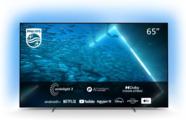Add devices to your profile, rate and comment on your smartphones...
Price comparison
Prices
In 5 stores
- 65"4KHDRG
- 144 cm81 cm7.5 cm
- OLED Self-luminous pixels
- 650 nits Infinite:1
- Total 70 W 2 x 20W1 x 30W
- DVB-TDVB-T2HbbTV
- Android TV 11
Image
OLED
- TechnologyOLEDOLED panels achieve an infinite contrast in a smaller thickness
- Reference imageFinal imagePerfectAn image with pure blacks, maybe the brightness and the life time are slightly lower than on an LCD panel
Size (inches) and resolution
- Diagonal
- 65 inches
- Resolution
- 4K • 3840 x 2160
- Aspect ratio
- 16:9
- Pixel density
- 68 ppi
Technology
- Panel type
- OLED
- Subpixel type
- RGB
- Refresh rate
- 120 Hz
- Panel Manufacturer
- LG Display • Lg Display
Backlight and contrast
- Backlight type
- Self-luminous pixels
- Brightness
- 650 nits
- Contrast
- Infinite:1
- Light sensor
- Sí
Colorimetry
- Quantum Dots
- No
- Color spaces
- Rec. 709
- 100%
- DCI P3
- 99%
- NTSC 1953
- --
- Rec. 2020
- --
- sRGB
- --
- Color depth
- 10 bits
HDR
- Tradename
- HDR
- HDR technologies
- Dolby Vision
- HDR10+
- HLG
Crystal
- Anti-glare filter
- --
- Vision angle
- Horizontal • Vertical
Processing
These features modify the images received by television via software, in many cases they create unwanted artifacts, we disable some of them, but here you have them ...
- Upscaling
- Ultra Resolution
- Motion
- Perfect Natural Motion
- Contrast
- Micro Dimming Perfect
Response times
- Minimum time
- --
- Average time
- --
- Input lag
- --
- Gaming
- FreeSync
Sound
Speakers
- Speakers
- 20W 2x
- Subwoofer
- 30W 1x
- Power
- 70 W
- Output channels
- 2.1 CH
Sound technologies
- Technologies
- Dolby Atmos
- Dolby Digital Plus
Tuner and connectivity
Digital tuner
DVB
- Terrestrial
- DVB-T
- DVB-T2
- Satellite
- DVB-S
- DVB-S2
- Cable
- DVB-C
- ATSC & QAM
- No
- ISDB
- No
- DTMB
- No
Analog tuner
- NTSC
- Yes
- PAL
- Yes
- SECAM
- Yes
Hybrid television
- HbbTV
- Yes
Cable connections
- RF antenna
- Antenna (RF) 1x
- HDMI
- HDMI 2.0 2x
- HDMI 2.1 2x
- HDCP 2.3
- USB
- USB 2.0 2x
- USB 3.0 1x
- Satellite
- Satellite In (Main; F-type female) 1x
- CI
- CI+ 1.4 1x
- Optical Audio
- Optical Audio Out 1x
- 3.5mm audio
- 3.5 mm Audio Out 2x
- Ethernet
- Ethernet RJ45 1x
Wireless connections
- Wi-Fi
- Yes • 802.11a, 802.11ac, 802.11b, 802.11g, 802.11n,
- Bluetooth
- Yes • Bluetooth 5
Content delivery
- Chromecast
- Yes
- DLNA
- Yes
- Wi-Fi Direct
- Yes
Remote control
- Type of command
- --
- Control of multiple devices
Others
- PVR recording
- No
- PIP
- No
- Extra
- DVB-T2 HD
System
Operating System
- SW
- Android • Android TV 11
Voice assistants
- Alexa
- Yes
- Google Assistant
- Yes
Hardware
- SOC model
- --
- RAM
- 4GB
- ROM
- 16GB
Consumption
- Energy efficiency
- G
- Standby consumption
- 0.3 W
- Average consumption
- 147 W
- Consumption
- 298 W
Power supply
- Power supply
- 220 V - 240 V (volts)
- Power supply frequency
- 50 Hz - 60 Hz (hertz)
More Philips 65-inch TVs
The information on this web site is not guaranteed. Kitele is not responsible for inaccuracies, omissions or any other error in the information. Any warranties regarding this information are disclaimed. Total or partial reproduction of this site is prohibited in any manner without prior written permission. The trademarks, logos and device manufacturers, software, etc. are the property of their respective owners.
Report an ErrorScore
- 8.8 Image
- 8.9 Sound
- 8.7 Connectivity
- 7.0 Design
- 7.9 System
In this case, to determine the score we evaluate 5 general aspects:
- Image
- Sound
- Connectivity
- Design
- System
Once these 5 factors have been rated, we introduce the price variable. This means that any two devices with the same ratings get a different Ki score for quality vs price.
Even a device objectively worse than another may have a higher Ki score if it has a better price.
The Ki varies as time goes by. As new devices with better specifications enter the market the Ki score of older devices will go down, always being compensated of their decrease in price.





